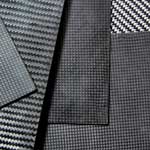Showing Spotlights 169 - 176 of 318 in category All (newest first):
 Buckypaper - in which CNTs collectively behave as a random web - is characterized by its optical transparency, mechanical flexibility, high electric conductivity, uniform dimensions, tunable electronic properties, large specific surface area and smooth surface topology. All of which make this a very promising material as functional element or structural component in a wide range of applications such as optoelectronics, nanocomposites, chemical separations, biocompatible platforms, electronics, and energy conversion and storage. So far it has been difficult to simultaneously retain the intrinsic properties of individual CNTs and to have versatility in creating different shapes, both problems unavoidably resulting from post-growth fabrication processes. A research group in China has now reported a simple approach for the direct and nondestructive assembly of multi-sheeted, single-walled carbon nanotube book-like macrostructures (buckybooks) of several millimeters in thickness with good control of the nanotube diameter, the sheet packing density, and the book thickness.
Buckypaper - in which CNTs collectively behave as a random web - is characterized by its optical transparency, mechanical flexibility, high electric conductivity, uniform dimensions, tunable electronic properties, large specific surface area and smooth surface topology. All of which make this a very promising material as functional element or structural component in a wide range of applications such as optoelectronics, nanocomposites, chemical separations, biocompatible platforms, electronics, and energy conversion and storage. So far it has been difficult to simultaneously retain the intrinsic properties of individual CNTs and to have versatility in creating different shapes, both problems unavoidably resulting from post-growth fabrication processes. A research group in China has now reported a simple approach for the direct and nondestructive assembly of multi-sheeted, single-walled carbon nanotube book-like macrostructures (buckybooks) of several millimeters in thickness with good control of the nanotube diameter, the sheet packing density, and the book thickness.
Mar 9th, 2009
 Currently, all existing methods of fabricating CNT-polymer composites involve quite complicated, expensive, time-demanding processing techniques such as solution casting, melting, molding, extrusion, and in situ polymerization. In all of these techniques, nanotubes must either be incorporated into a polymer solution, molten polymer or mixed with the initial monomer before the formation of the final product. In addition, these methods can not be applied in the case of insoluble or temperature sensitive polymers, which decompose without melting. Kevlar is a well known high-strength polymer with a variety of important applications - think bullet-proof vests and car armor plating. However, Kevlar is not soluble in any common solvent and Kevlar fibers must be produced by wet spinning from sulphuric acid solutions. Researchers in Ireland have now found a way to develop a new effective post-processing technique which would allow to incorporate carbon nanotubes into already formed polymer products, such as for example Kevlar yarns.
Currently, all existing methods of fabricating CNT-polymer composites involve quite complicated, expensive, time-demanding processing techniques such as solution casting, melting, molding, extrusion, and in situ polymerization. In all of these techniques, nanotubes must either be incorporated into a polymer solution, molten polymer or mixed with the initial monomer before the formation of the final product. In addition, these methods can not be applied in the case of insoluble or temperature sensitive polymers, which decompose without melting. Kevlar is a well known high-strength polymer with a variety of important applications - think bullet-proof vests and car armor plating. However, Kevlar is not soluble in any common solvent and Kevlar fibers must be produced by wet spinning from sulphuric acid solutions. Researchers in Ireland have now found a way to develop a new effective post-processing technique which would allow to incorporate carbon nanotubes into already formed polymer products, such as for example Kevlar yarns.
Feb 25th, 2009
 Back in 2006, researchers introduced the concept of a carbon nanotube (CNT) knife that, in theory, would work like a tight-wire cheese slicer. In the meantime, other research groups have developed similar approaches, for instance for cutting and sharpening carbon nanotubes (see for instance: Nanotechnology grinders). Now, the group that introduced the CNT nanoknife in 2006 has refined their design and demonstrated the feasibility of fabricating a nanoknife (compression-cutting tool at the nanoscale) based on an individual CNT. The researchers stretched an individual nanotube between two tungsten needles in a manner that allowed them to test the mechanical strength of assembled device. A force test on the prototype nanoknife indicated that failure was at the weld while the CNT was unaffected by the force we applied. In situ load tests on the nanoknife indicated maximum breaking force to be in micro Newton range.
Back in 2006, researchers introduced the concept of a carbon nanotube (CNT) knife that, in theory, would work like a tight-wire cheese slicer. In the meantime, other research groups have developed similar approaches, for instance for cutting and sharpening carbon nanotubes (see for instance: Nanotechnology grinders). Now, the group that introduced the CNT nanoknife in 2006 has refined their design and demonstrated the feasibility of fabricating a nanoknife (compression-cutting tool at the nanoscale) based on an individual CNT. The researchers stretched an individual nanotube between two tungsten needles in a manner that allowed them to test the mechanical strength of assembled device. A force test on the prototype nanoknife indicated that failure was at the weld while the CNT was unaffected by the force we applied. In situ load tests on the nanoknife indicated maximum breaking force to be in micro Newton range.
Feb 18th, 2009
 Just a few days ago we covered the exciting and quickly developing world of nanotechnology machinery, specifically nanomotors. In this previous Nanowerk Spotlight we focused on one approach to nanomotors, which is copying nature's catalytic biomotors. Today we will look at an example of mechanical approach that works with carbon nanotubes (CNTs). Some experimental work concerning CNT motor system has already been reported, but new work coming out of Japan could very well be the smallest motor so far. Researchers in Japan investigated the linear and rotary motions of a CNT capsule at room temperature when it is sealed by other CNTs in a hollow space of a host CNT. It is the first observation of linear motion of CNT capsules. Such a system can be obtained by simply heating C60 peapods, and its size is comparable or much smaller than well-known protein-based molecular motors in the bioengineering field.
Just a few days ago we covered the exciting and quickly developing world of nanotechnology machinery, specifically nanomotors. In this previous Nanowerk Spotlight we focused on one approach to nanomotors, which is copying nature's catalytic biomotors. Today we will look at an example of mechanical approach that works with carbon nanotubes (CNTs). Some experimental work concerning CNT motor system has already been reported, but new work coming out of Japan could very well be the smallest motor so far. Researchers in Japan investigated the linear and rotary motions of a CNT capsule at room temperature when it is sealed by other CNTs in a hollow space of a host CNT. It is the first observation of linear motion of CNT capsules. Such a system can be obtained by simply heating C60 peapods, and its size is comparable or much smaller than well-known protein-based molecular motors in the bioengineering field.
Feb 17th, 2009
 One of the many application areas that carbon nanotubes (CNTs) are experimented with is as a drug carrier in nanomedicine. Typically, nanoparticles have been used for drug delivery and it is only recently that carbon nanotubes have gained attention as potential drug delivery vehicles. Current research has shown the ability of CNTs to carry a variety of molecules such as drugs, DNA, proteins, peptides, targeting ligands etc. into cells - which makes them suitable candidates for targeted delivery applications. Polyethylene glycol (PEG) with molecular weight between 1 and 40 kDa is usually used to coat drug or imaging nanocarriers with the purpose of reducing non-specific interactions with cells and thus increasing the nanocarriers circulation time in vivo. However, when PEG in the form of PL-PEG (adsorbing phospholipid-PEG) has been used to functionalize single-walled CNTs, the finding were not consistent, sometimes even contradictory.
One of the many application areas that carbon nanotubes (CNTs) are experimented with is as a drug carrier in nanomedicine. Typically, nanoparticles have been used for drug delivery and it is only recently that carbon nanotubes have gained attention as potential drug delivery vehicles. Current research has shown the ability of CNTs to carry a variety of molecules such as drugs, DNA, proteins, peptides, targeting ligands etc. into cells - which makes them suitable candidates for targeted delivery applications. Polyethylene glycol (PEG) with molecular weight between 1 and 40 kDa is usually used to coat drug or imaging nanocarriers with the purpose of reducing non-specific interactions with cells and thus increasing the nanocarriers circulation time in vivo. However, when PEG in the form of PL-PEG (adsorbing phospholipid-PEG) has been used to functionalize single-walled CNTs, the finding were not consistent, sometimes even contradictory.
Feb 16th, 2009
 Platinum nanoparticles are widely used as the cathode material in hydrogen/oxygen fuel cells due to their efficiency in catalyzing the oxygen reduction reaction (ORR), the process that breaks the bonds of the oxygen molecules. Although platinum is still considered the state-of-the-art ORR catalyst, it does not exhibit good stability. Typically, catalyst performance degradation begins as soon as the catalyst is introduced into a fuel cell and continues until it is no longer active. Platinum can lose its effectiveness either by clumping together or by becoming 'poisoned' by carbon monoxide, requiring high hydrogen purity or higher catalyst densities for the fuel cell to stay effective. This, together with the high cost of platinum is seen as one of the major showstoppers to producing mass market fuel cells for commercial applications. Researchers now found that vertically-aligned nitrogen-containing carbon nanotubes could be used as effective ORR electrocatalysts.
Platinum nanoparticles are widely used as the cathode material in hydrogen/oxygen fuel cells due to their efficiency in catalyzing the oxygen reduction reaction (ORR), the process that breaks the bonds of the oxygen molecules. Although platinum is still considered the state-of-the-art ORR catalyst, it does not exhibit good stability. Typically, catalyst performance degradation begins as soon as the catalyst is introduced into a fuel cell and continues until it is no longer active. Platinum can lose its effectiveness either by clumping together or by becoming 'poisoned' by carbon monoxide, requiring high hydrogen purity or higher catalyst densities for the fuel cell to stay effective. This, together with the high cost of platinum is seen as one of the major showstoppers to producing mass market fuel cells for commercial applications. Researchers now found that vertically-aligned nitrogen-containing carbon nanotubes could be used as effective ORR electrocatalysts.
Feb 5th, 2009
 Typically, nanoparticles have been used for drug delivery and it has been only recently that carbon nanotubes (CNTs) have gained attention as potential drug delivery vehicles. Carbon nanotubes offer a number of advantages which suggest that they may provide an improved result over nanoparticles. They have a larger inner volume which allows more drug molecules to be encapsulated, and this volume is more easily accessible because the end caps can be easily removed, and they have distinct inner and outer surfaces for functionalization. Current research has shown the ability of CNTs to carry a variety of molecules such as drugs, DNA, proteins, peptides, targeting ligands etc. into cells - which makes them suitable candidates for targeted delivery applications. Despite these advantages, a suitable delivery system has not been developed yet for the targeted delivery of CNTs to specific sites.
A research team from various Canadian and U.S. universities has now demonstrated, for the first time, the design and development of a novel microcapsule carbon nanotube targeted delivery device.
Typically, nanoparticles have been used for drug delivery and it has been only recently that carbon nanotubes (CNTs) have gained attention as potential drug delivery vehicles. Carbon nanotubes offer a number of advantages which suggest that they may provide an improved result over nanoparticles. They have a larger inner volume which allows more drug molecules to be encapsulated, and this volume is more easily accessible because the end caps can be easily removed, and they have distinct inner and outer surfaces for functionalization. Current research has shown the ability of CNTs to carry a variety of molecules such as drugs, DNA, proteins, peptides, targeting ligands etc. into cells - which makes them suitable candidates for targeted delivery applications. Despite these advantages, a suitable delivery system has not been developed yet for the targeted delivery of CNTs to specific sites.
A research team from various Canadian and U.S. universities has now demonstrated, for the first time, the design and development of a novel microcapsule carbon nanotube targeted delivery device.
Jan 19th, 2009
 Olfaction, our sense of smell, depends on the capability of specialized sensory cells in the nose to detect airborne odorant molecules. These olfactory cells contain specific protein molecules that acts as 'olfactory receptors' - they bind only to specific odorant molecules present in the air inhaled through the nose. When such a binding event occurs, the olfactory receptors change their shape and this deformation triggers chemical and electrical signals which are eventually transmitted to the brain through neurons. So, in a nutshell, this is how we smell. Human and especially some animal noses (think bomb-sniffing dogs) are very sophisticated and extremely sensitive gas sensors that can distinguish between very similar gas molecules. Researchers have been trying for a while to replicate the human olfactory sense - a concept called electronic nose (e-nose). While most nanotechnology-based efforts have focused on nanowires, new research conducted in Korea has demonstrated the detection of specific odorant molecules with a single-carbon-atomic resolution using a human olfactory receptor-functionalized carbon nanotube based sensor.
Olfaction, our sense of smell, depends on the capability of specialized sensory cells in the nose to detect airborne odorant molecules. These olfactory cells contain specific protein molecules that acts as 'olfactory receptors' - they bind only to specific odorant molecules present in the air inhaled through the nose. When such a binding event occurs, the olfactory receptors change their shape and this deformation triggers chemical and electrical signals which are eventually transmitted to the brain through neurons. So, in a nutshell, this is how we smell. Human and especially some animal noses (think bomb-sniffing dogs) are very sophisticated and extremely sensitive gas sensors that can distinguish between very similar gas molecules. Researchers have been trying for a while to replicate the human olfactory sense - a concept called electronic nose (e-nose). While most nanotechnology-based efforts have focused on nanowires, new research conducted in Korea has demonstrated the detection of specific odorant molecules with a single-carbon-atomic resolution using a human olfactory receptor-functionalized carbon nanotube based sensor.
Jan 8th, 2009
 Buckypaper - in which CNTs collectively behave as a random web - is characterized by its optical transparency, mechanical flexibility, high electric conductivity, uniform dimensions, tunable electronic properties, large specific surface area and smooth surface topology. All of which make this a very promising material as functional element or structural component in a wide range of applications such as optoelectronics, nanocomposites, chemical separations, biocompatible platforms, electronics, and energy conversion and storage. So far it has been difficult to simultaneously retain the intrinsic properties of individual CNTs and to have versatility in creating different shapes, both problems unavoidably resulting from post-growth fabrication processes. A research group in China has now reported a simple approach for the direct and nondestructive assembly of multi-sheeted, single-walled carbon nanotube book-like macrostructures (buckybooks) of several millimeters in thickness with good control of the nanotube diameter, the sheet packing density, and the book thickness.
Buckypaper - in which CNTs collectively behave as a random web - is characterized by its optical transparency, mechanical flexibility, high electric conductivity, uniform dimensions, tunable electronic properties, large specific surface area and smooth surface topology. All of which make this a very promising material as functional element or structural component in a wide range of applications such as optoelectronics, nanocomposites, chemical separations, biocompatible platforms, electronics, and energy conversion and storage. So far it has been difficult to simultaneously retain the intrinsic properties of individual CNTs and to have versatility in creating different shapes, both problems unavoidably resulting from post-growth fabrication processes. A research group in China has now reported a simple approach for the direct and nondestructive assembly of multi-sheeted, single-walled carbon nanotube book-like macrostructures (buckybooks) of several millimeters in thickness with good control of the nanotube diameter, the sheet packing density, and the book thickness.
 Subscribe to our Nanotechnology Spotlight feed
Subscribe to our Nanotechnology Spotlight feed





